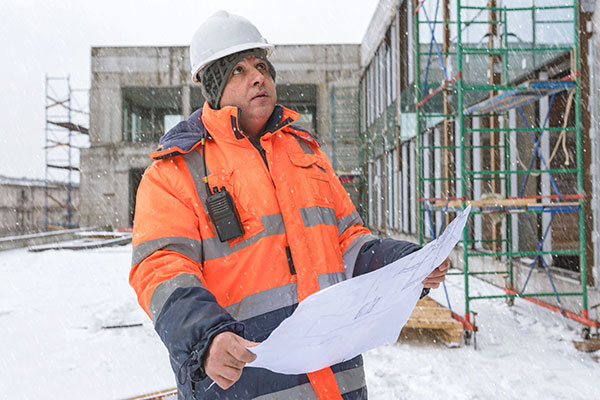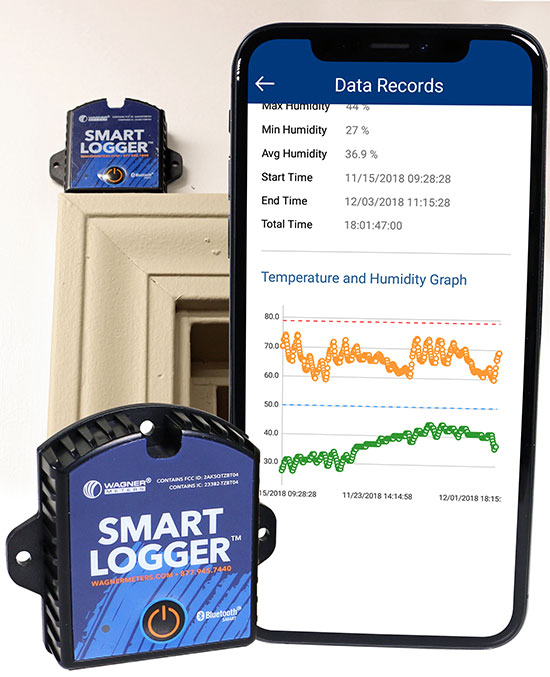Raise Your Reputation and Lower the Complication with These Concrete RH Testing Best Practices, Pt. 1

Data loggers can help you monitor job site ambient conditions before testing begins and over the course of the project. They are great way to collect an unquestionable record of whether service conditions exist for the next phase of the project to begin.
Whether you’re a small, medium, or large scale flooring professional, working on a residential flooring project or commercial flooring project, the fundamentals for success stay the same; be prepared, work with the right tools, work safe, and most importantly, communicate.
Let’s add another vital component to the list; education. That’s where this article (and part 2) can help you with some concrete moisture testing tips and best practices that will help raise your reputation and lower your complication.
Are You Prepared?
Benjamin Franklin is credited with saying “Those who fail to prepare, prepare to fail.” In the military, they say it with the five P’s: “Proper preparation prevents poor production.” Any way you say it, the guidance clearly points to the fact that good preparation can greatly enhance your chances of success, not to mention, minimize the stress and pressure during the job.
This can be said of any flooring installation, inspection, or repair project. And because the results need to be absolutely correct, concrete moisture testing can get mighty stressful if you’re not prepared.
Whether it’s a residential or commercial job site, your company has to be prepared for whatever testing is required. If concrete moisture testing is involved, one of the best ways to ensure that you are prepared is to get a concrete moisture testing certification like International Concrete Repair Institute (ICRI) (https://www.icri.org/). It’s not mandatory that you do this, but it helps ensure proper compliance with the ASTM standards.
Testing concrete slabs isn’t simply about drilling holes, placing plastic domes, or dipping pH paper in a puddle of water. To those who have been burned by concrete slab failures on projects before, it is indeed a wake-up call. It is about acquiring and maintaining the professionally recognized competency needed to ensure third-party results are correctly obtained and certified.
A testing technician should be fully insured with the liability coverage needed for the size and scope of the project exposure involved. While this sounds like a lot, reliable results are what make a certified concrete slab testing technician the best choice for third-party moisture testing of concrete slabs at residential and commercial job sites.
For in-situ concrete slab relative humidity (RH) testing, a testing technician needs to have properly calibrated NIST-traceable sensors. Wagner’s Rapid RH® sensors are used by quite a number of testing and inspection professionals because it is easy to ensure the calibration credentials.
Whatever testing system your technician uses, it’s a good idea for them to carry a copy of the applicable ASTM standard for that test method. If you are employing in-situ probes to determine RH in concrete slabs, that standard is ASTM F2170. You never know when they might be asked to verify compliance by someone else in authority at the project jobsite.
The Right Tools

Wagner makes a small, easy-to-use Bluetooth capable temperature and relative humidity logger called the Smart Logger which captures up to 12,000 readings over a period of up to 300 days of replaceable battery life.
Safety is paramount during every function and practice performed. This involves tool use, wearing the essential personal protective gear, and knowing beforehand what the working conditions are going to be upon your arrival. Wear safety glasses and NIOSH-95 paper filter masks, or cartridge respirators, and keep them close by for use as needed. Protect your exposed skin, eyes, and head. Losing any of those during an on-the-job accident could significantly impede your progress in this business.
Smartphone apps are gaining popularity within the construction industry for their ability to import data, provide analytical tools, and export the results via email and print documents. Another innovation that is gaining rapid acceptance and utilization within the flooring industry is data-logging thermo-hygrometers that can record ambient temperature and relative humidity conditions.
Monitoring jobsite ambient conditions, before testing begins and over the course of the project, is a great way to collect an unquestionable record of whether conditions of readiness exist for the next phase of the project to begin. The data record can help protect you from liability or finger pointing in case the service conditions were below optimal while you away from the job site waiting to install. Wagner makes a small, easy-to-use Bluetooth capable temperature and relative humidity logger called the Smart Logger which captures up to 12,000 readings over a period of up to 300 days of replaceable battery life. The Smart Logger connects to a smart device app that allows you to download captured data, analyze, and either print or email the results as needed.
If you are employing the ASTM F2170 standard for your concrete slab moisture testing, your drill bits need to be in excellent condition and not excessively worn, otherwise, it will make the concrete RH sensor insertion difficult or impossible. An SDS hammer drill is your best and only choice for optimal drilling in concrete slabs.

Dust extraction is now a major concern because of the new OSHA Compliance Standard 29 CFR 1926.1123.
Dust extraction is now a major concern because of the new OSHA Compliance Standard 29 CFR 1926.1123. In effect since September 2017, it states, in part, that HEPA-filtered vacuums are required to clean drilled holes and that the drill used must be equipped with a commercially available shroud or cowling with the dust collection system. Check your dust extractor for fresh vacuum bags and clean your HEPA filters before each use; make sure your dust extractor can be HEPA verified if called upon. Hilti manufactures the TE-CD Hammer Drill Bit – a powerful and rugged tool for quickly drilling clean and dust-free holes.
Make sure your tools can be transported easily; rolling Festool Sys-Carts are seen on a lot of job sites nowadays. You can also use rolling Pelican cases that can hold the essential drilling tools, hand tools, and vacuum systems. Whatever method you employ, make sure it can move freely and quickly up and down levels of the building.
Part 2 of this article series will address the importance of good communication practices as well as listing some of the salient points of proper ASTM F2170 concrete moisture testing with in-situ probes.